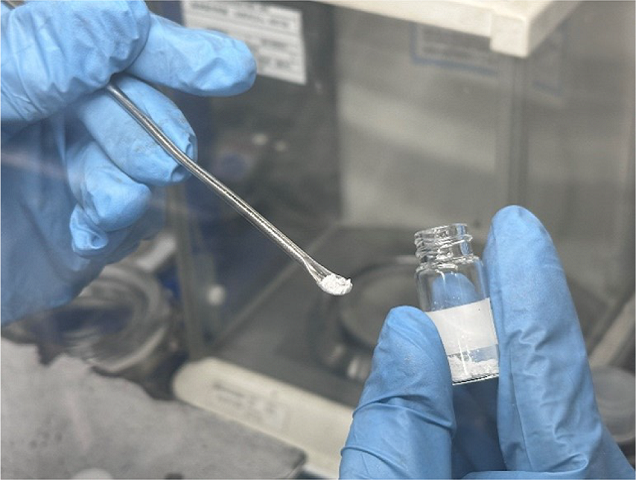Research News
Oct 2, 2024
- Engineering
Discovery of promising electrolyte for all-solid-state batteries
Solid electrolyte composed of nanoparticles embedded in an amorphous matrix shows high conductivity, formability, and electrochemical stability
Solid sodium-ion conducting chloride electrolyte
Osaka Metropolitan University researchers discovered this solid electrolyte, Na2.25TaCl4.75O1.25, which has the potential to be a suitable material for all-solid-state batteries.
Credit: Osaka Metropolitan University

Often overlooked, rechargeable batteries play an important part in contemporary life, powering small devices like smartphones to larger ones like electric vehicles. The keys to creating sustainable rechargeable batteries include having them hold their charge longer, giving them a longer life with more charging cycles, and making them safer. Which is why there is so much promise in all-solid-state batteries.
The problem so far is discovering which solid electrolytes offer such potential advantages.
In a step toward that goal, an Osaka Metropolitan University research group led by Assistant Professor Kota Motohashi, Associate Professor Atsushi Sakuda, and Professor Akitoshi Hayashi of the Graduate School of Engineering has developed an electrolyte with high conductivity, formability, and electrochemical stability.
The group achieved high conductivity at room temperature by adding Ta2O5 (tantalum pentoxide) to the previously developed solid electrolyte NaTaCl6, a combination of tantalum chloride and sodium chloride.
The discovered solid electrolyte, Na2.25TaCl4.75O1.25, also has a higher electrochemical stability than conventional chlorides and superior mechanical properties.
“The results of this research are expected to make a significant contribution to the development of composite solid electrolytes, in addition to the glass and crystal solid electrolytes that have been developed to date,” Professor Motohashi suggested. “We will now be focusing on elucidating the ionic conduction mechanism of composite solid electrolytes and further developing materials.”
The findings were published in Chemistry of Materials.
Funding
This study was partly supported by JSPS KAKENHI (Grant Numbers JP24H02204, JP21H04701, and JP19H05816), the MEXT Program: Data Creation and Utilization-Type Material Research and Development Project Grant Number JPMXP1122712807. Synchrotron radiation experiments were performed at the BL11 of the SAGA Light Source (no. 152-2302127T). The authors thank Hiroyuki Setoyama for their technical support with the XAFS measurements.
Paper information
Journal: Chemistry of Materials
Title: Fast Sodium-Ion Conducting Amorphous Oxychloride Embedding Nanoparticles
DOI: 10.1021/acs.chemmater.4c02104
Authors: Kota Motohashi, Hirofumi Tsukasaki, Shigeo Mori, Atsushi Sakuda, and Akitoshi Hayashi
Published: 24 September 2024
URL: https://doi.org/10.1021/acs.chemmater.4c02104
Contact
Graduate School of Engineering
Email: kota.motohashi[at]omu.ac.jp
*Please change [at] to @.
SDGs
